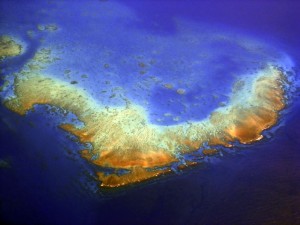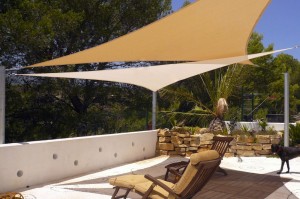
A paper recently published in Nature Climate Change speaks of a plan devised by scientists in Australia to protect the Great Barrier Reef from damage by installing shade sails on the surface of the ocean above the fragile coral reef. The proposal would mean covering the reefs with cloth thus shading them from sunlight which would reduce the bleaching that is damaging them so intensively. The massive sheets of cloth would be anchored with ropes attached to pontoons and made to float on the surface of the water in a bid to shield the reef from the strong rays of sunlight.
Australian marine biologist Russell Hore said that while the idea had seemed laughable, everything had to be considered to protect the World Heritage-listed reef. “Although it would be impossible to shade all 348,000 square kilometers of the entire reef, an area of small shade cloths will prove that coral bleaching can be tackled by reducing light and temperature”, he said.
“In particular, various methods for reducing or mitigating thermal stress in corals have been proposed or demonstrated. For example, efforts to artificially shade sections of a reef during periods of thermal stress using buoyant shade cloth have been applied on the Great Barrier Reef. Light exacerbates the effect of heat stress and causes reef-building corals to bleach. Consequently, shading corals can reduce the extent of coral bleaching.”
Ove Hoegh-Guldberg
Ove Hoegh-Guldberg of the University of Queensland’s Global Change Institute warned time for saving the reef through global action on climate change may be running out and he called for more studies into solutions. Other ideas suggested by Ove Hoegh-Guldberg and his colleagues include using low-voltage electric currents to stimulate coral growth, genetic engineering to help marine life cope and a plan to add base minerals to the waters around the reef to help offset higher levels of acidity, which harm the coral.
 The study states that global warming has led to rising temperatures of at least 2ºC and contributed to a staggering 60 per cent increase in surface ocean acidity in the last 300 years. Scientists warned earlier this year that high ocean temperatures linked to global warming had caused severe coral bleaching in parts of the reef. Bleaching occurs when organisms that make up coral die and leave behind the white limestone skeleton of the reef.
The study states that global warming has led to rising temperatures of at least 2ºC and contributed to a staggering 60 per cent increase in surface ocean acidity in the last 300 years. Scientists warned earlier this year that high ocean temperatures linked to global warming had caused severe coral bleaching in parts of the reef. Bleaching occurs when organisms that make up coral die and leave behind the white limestone skeleton of the reef.
Ove Hoegh-Guldberg and other scientists say that drastic measures will have to be considered to save small parts of the reef, however, even with the sophisticated techniques being implemented they would not be able to save the Great Barrier Reef as a whole.
Bonkers?
Joanne Nova, an unfunded non-government critic said:
We need scientists who are mature enough to spot a plan that is bonkers.
The Great Barrier Reef has an area of 348,000 square kilometers. It’s bigger than the UK, Holland and Switzerland combined. So perhaps we could just cover 1%, that’s only three and a half thousand square kilometers and then ask the water to stay in one spot?
The idea apparently is not to drive thousands of pylons into the reef (phew), just to cover “hundreds of square meters” with floating shade material. One wonders how predatory sea-birds will feel about this, not to mention photosynthetic marine life. Air breathing mammals might not “feel right at home” under the shades. (But its not like anyone cares about whales and dolphins right?) Tidal and wave action, with floating material near lots of spiky coral and rocks suggests maintenance could be “expensive”.
The suggestion of floating shade sails over the Great Barrier Reef has been called laughable by a great many people on internet forums. Statements I found include:
– “Sounds like someone’s been out in the sun too much and needs that shade cloth over their head.”
– “Yes, because it’s not like the reef ecosystem depends on sunlight or anything – Oh wait…”
– “I think the shade cloth needs to be anchored to reality.”
Protecting the Great Barrier Reef (and all of Planet Earth) should be a priority for all of us and our respective governments, but it would appear that there are some major flaws in this plan.
What do Coolashade think?
The plan was first noticed by us in 2006 here and although there has been a two year study into placing sun shades over the Great Barrier Reef we feel that shade sails are more appropriate for protecting things on the land as opposed to the oceans. We would love to see the Great Barrier Reef protected in some way but perhaps shade sails are not the way to go, however if the Australian Government are reading this then we would be very happy to give you a quote!
 Coolashade manufacture custom made shade sails to protect people and possessions from the harsh UV rays produced by the sun. Our sun shades are used in gardens up and down the Costa Blanca in Spain and throughout Europe. They can be used over patios and pools for cooling protective shade, in bars and restaurants to give relief to customers and diners, as car-ports to stop sun damage to vehicles, and in businesses to protect staff and products.
Coolashade manufacture custom made shade sails to protect people and possessions from the harsh UV rays produced by the sun. Our sun shades are used in gardens up and down the Costa Blanca in Spain and throughout Europe. They can be used over patios and pools for cooling protective shade, in bars and restaurants to give relief to customers and diners, as car-ports to stop sun damage to vehicles, and in businesses to protect staff and products.
In fact Coolashade Shade Sails have so many uses that you will want to find out more by visiting www.coolashade.com or by calling 697 571 248 today.
References:
The paper:
- Rau, G., McLeod, E.L. & Hoegh-Guldberg, O. (2012) The need for new ocean conservation strategies in a high-carbon dioxide world Nature Climate Change doi:10.1038/nclimate1555
Websites:
